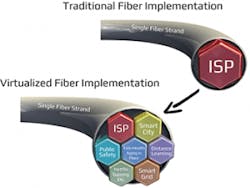Every City Needs a Broadband Strategy
5 Key Strategic Recommendations for Municipal Broadband Planning
The range of broadband issues relevant to municipal leaders continues to grow. Pressing issues at the national and local level include the lack of competitive options for Internet access, the high cost of services, requests by wireless companies to site 5G cell towers around the city, the impact of the digital divide on underprivileged citizens, privacy issues, net neutrality, and, perhaps the most important issue: the impact of communications on economic development. The harsh reality is that negative growth (the opposite of economic development) will increasingly happen in communities with broadband infrastructure that does not favor the consumer.
Until now, municipalities have mostly watched from the sidelines while private companies have taken control of wireless and wired communications systems. With that control, these companies have decided where they will build, what they will build, what the price will be, what services will operate on their network, and the type of innovation that occurs.
However, because the network is now so fundamental to nearly every aspect of modern life, municipalities can no longer afford to merely watch from the sidelines. Municipal leaders must gain a more comprehensive understanding of how networks work and the interdependencies between networks and other technologies that increasingly impact the livability of a community.
Local leaders cannot afford to ignore current broadband issues and should not continue to outsource the resolution of these issues to the large incumbent providers with the naïve hope that these companies will do what is best for consumers. Planning and thoughtful broadband strategies are necessary to protect the long-term viability of communities.
The fundamental problem facing nearly every community across North America is this: Incumbent network operators want to serve just enough to make the maximum profit. Cities are incentivized to build networks which profit just enough to provide the maximum service. While large ISPs seek to maximize the return on their investment, municipalities have a much broader and different set of interests related to broadband infrastructure. These interests include economic development, livability, public safety, education, healthcare, emergency communications, smart grid, efficient government services, environmental stewardship, universal access, and smart city applications. All these things are now network-dependent, and the value from the network to municipalities can align perfectly with the interests of individual businesses, residents, and anchor institutions, who subscribe to the network.
Both the municipality as a whole and the individual subscriber will benefit from universal access, abundant bandwidth, affordable prices, and local control of infrastructure. As a result, municipalities are becoming increasingly aware that broadband infrastructure is strategically important and should be controlled by the municipality for the good of all stakeholders.
A recent article by The Crypto Oracle for ALTCOIN MAGAZINE, The Fourth Industrial Revolution: The Rise Of The Autonomous Economy, details the convergence of technology trends that are now generating The Fourth Industrial Revolution. Any community with an eye to the future must consider not only what we need from our networks today, but also what the network will need to do in 2030. The Autonomous Economy is upon us and brings with it an acceleration of automation, sensors, robots, real-time response to data analytics, and use of distributed ledger technologies. The Crypto Oracle summarizes what is needed this way:
"The ideal infrastructure for an autonomous economy requires a database, a processing layer, a transactional layer, and a connectivity layer, which allows any system to receive inputs and send outputs to any other system. The network must be secure, operate in real time, and provide confidentiality options when needed. It also must provide receipts for all parties involved, be cooperative with the law, and properly monetize the value on it. Finally, it must be permissionless and public to facilitate the network effects needed for maximum connection."
InvisiLight® Solution for Deploying Fiber
April 2, 2022Go to Market Faster. Speed up Network Deployment
April 2, 2022Episode 10: Fiber Optic Closure Specs Explained…
April 1, 2022Food for Thought from Our 2022 ICT Visionaries
April 1, 2022Current broadband networks (the connectivity layer) are built on a closed access model that creates rigid silos that constrain the free flow of inputs and outputs to other systems and therefore, don’t provide the flexibility needed in an autonomous economy. Rather than being permissionless and public, the opposite is the order of the day.
Access to the network is strictly controlled by the large ISPs who maintain their quasi-monopolistic positions by also controlling the infrastructure. Incumbent ISPs are hoping that the promised benefits of 5G will help people forget what is so distasteful to consumers about the way our broadband networks operate. The current marketing efforts by incumbents to convince consumers and political leaders that 5G is coming to the rescue for all that ails our broadband infrastructure and systems is a myth. The next generation of technology advances is real and will likely bring faster speeds, lower latency, and network virtualization. However, the fundamental misalignment of interests will not change.
Figure 1. Virtualization allows us to do more with Broadband.
The Autonomous Economy requires Open Access networks that allow us to do much more across the network than merely give us access to the Internet. Traditional broadband networks allow for a small subset of services driven by the financial objectives of the provider. Municipal broadband infrastructure can allow for a multitude of network services, driven by customer needs and demand, to be delivered across a single fiber optic strand that goes to the premises. (See Figure 1.)
Emerging services will require advanced networking capabilities supported by business models that allow the network to evolve with the needs of networks users. This kind of Open Access extends well beyond an ecosystem of choices for ISPs.
The coming technology revolution will require a connectivity layer that is open to innovation and competition. Network access needs to be open like the Internet itself. This kind of open network is enabled only by cities that have taken the time to understand both what is needed and what is possible. City leaders must do more than hand-waving toward the strategic importance of broadband networks; they must take on the hard work of planning and building networks that can evolve to meet the future needs of both the city and its residents.
5 Key Strategic Recommendations
The following are 5 key strategic recommendations we make to our municipal clients to direct their broadband planning.
Recommendation #1. Digital roads will be as important in the next 50 years as physical roads have been in the past 50 years. Digital roads should be organized like physical roads. Municipalities should own and control digital roads, and the Private Sector should provide services running over those roads.
Recommendation #2. Systems which separate infrastructure and services, and force services to the Cloud, will lead to real competition, lower prices, and accelerated innovation.
Recommendation #3. By owning and controlling essential broadband infrastructure, cities can create networks that are flexible, evolvable, scalable, and sustainable.
Recommendation #4. There is enough money being spent every year by consumers to fund robust fiber optic networks throughout any city. The problem is not where to find the money but rather what financial structure is appropriate to finance strategic projects. Cities are positioned to simultaneously lower costs and drive up value for consumers.
Recommendation #5. In the absence of municipal intervention, current broadband providers will trend toward monopolies with higher prices and lower value. As recently happened with FCC regulations for 5G cell placement, cities will increasingly lose control and influence over this essential infrastructure if they don’t approach broadband communications strategically.
Citizens need leaders with the political will to take on and solve these problems for the communities they serve. There are far-reaching and long-lasting implications for cities when leaders choose not to actively manage their city’s broadband future.
The first step is to begin the process of creating a vision that thoughtfully considers what the future will require, and then ground that vision in a strategy that produces a network that is robust, flexible, and evolvable.
For more information about the article The Fourth Industrial Revolution: The Rise Of The Autonomous Economy please visit https://medium.com/altcoin-magazine/the-fourth-industrial-revolution-the-rise-of-the-autonomous-economy-cfe0886ad8b3.
About the Author






